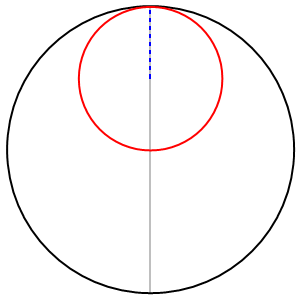 | ||
The Tusi couple is a mathematical device in which a small circle rotates inside a larger circle twice the diameter of the smaller circle. Rotations of the circles cause a point on the circumference of the smaller circle to oscillate back and forth in linear motion along a diameter of the larger circle.
Contents
Original description
Some modern commentators also call the Tusi couple a "rolling device" and describe it as a small circle rolling inside a large fixed circle. However, Tusi himself described it differently:
If two coplanar circles, the diameter of one of which is equal to half the diameter of the other, are taken to be internally tangent at a point, and if a point is taken on the smaller circle—and let it be at the point of tangency—and if the two circles move with simple motions in opposite direction in such a way that the motion of the smaller [circle] is twice that of the larger so the smaller completes two rotations for each rotation of the larger, then that point will be seen to move on the diameter of the larger circle that initially passes through the point of tangency, oscillating between the endpoints.Creation
The couple was first proposed by the 13th-century Persian astronomer and mathematician Nasir al-Din al-Tusi in his 1247 Tahrir al-Majisti (Commentary on the Almagest) as a solution for the latitudinal motion of the inferior planets, and later used extensively as a substitute for the equant introduced over a thousand years earlier in Ptolemy's Almagest.
Nasir al-Din al-Tusi, born in the town of Tus in 1201, is acknowledged throughout the Islamic world as one of the 'Great Wisdoms'. Tusi was the first astronomer to attempt a solution which would provide for latitudinal motion without introducing a longitudinal component. To do so, he proposed in a work called Tahrlr al-Majisti, which was completed in 1247, that the oscillatory motion be produced by the combined uniform circular motions of two identical circles, one riding on the circumference of the other. At that point, Tusi simply states that if one of these circles were to move at a uniform speed equal to twice the speed of the other, and in a direction to it, then any point on the circumference of the first circle would oscillate in a straight line along one of the diameters of the second circle
Later examples
Although the Tusi couple was developed within an astronomical context, later mathematicians and engineers developed similar versions of what came to be called hypocycloid straight-line mechanisms. The mathematician Gerolamo Cardano designed a system known as Cardan's movement. Nineteenth-century engineers James White, Matthew Murray, as well as later designers, developed practical applications of the hypocycloid straight-line mechanism.
